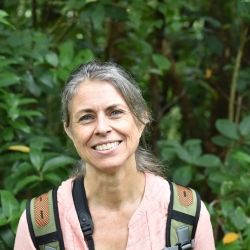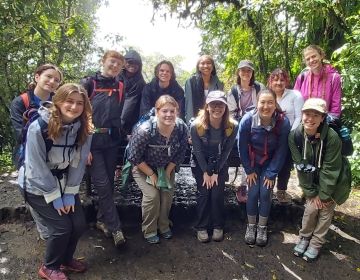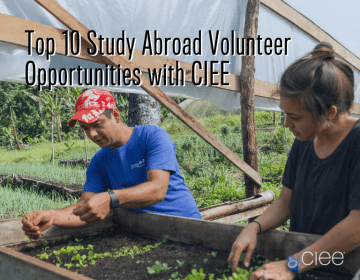CIEE INTERNSHIP INVESTIGATING THE REPRODUCTIVE ECOLOGY OF AN ENDANGERED TREE SPECIES IN MONTEVERDE, COSTA RICA
In Monteverde, a number of large bird species specialize in eating the fruit of the avocado family (Lauraceae). Three of these species—the Black Guan, the Three-wattled Bellbird, and the Resplendent Quetzal—are threatened with extinction. One of their preferred fruits is the wild avocado species, Ocotea monteverdensis. Unfortunately, this tree species itself is considered “critically endangered”. This internship investigates basic aspects of the reproductive ecology of this species to supply the conservation community with recommendations for how to protect this tree species, and the biodiversity that it supports. Two students, Jessica Sciara (Temple University) and Christie Fite (University of Washington) worked with biologist Dr. Dev Joslin to take on the challenge of collecting data in Monteverde's cloud forest to supply this vital information.
Collecting data on Ocotea monteverdensis: Christie Fite (sitting), Jessica Sciara (standing), and Dev Joslin (looking up). What's up there, Dr. Dev? Christie (left) and Jessica (center) in the cloud forest of MonteverdeJessica Sciara (Temple University)
Jessica measures canopy densityFor the past three weeks I have had the pleasure of working outdoors in the Monteverde forest searching for a critically endangered tree species Ocotea monteverdensis. When I first began working with Dev Joslin and a fellow student Christie Fite, I thought I would never be able to Identify this random tree out of the millions of plants growing all around. However, after just one day I was able to begin identifying the rusty red fuzz that indicates new growth, the bright green color of the leaves, and even their specific shape and vein patterns. Once I began looking it was hard to stop! I became increasingly excited with each new seedling I was able to come across and add to our data. After learning to identify the trees we came up with a list of measurements we wanted to record such as height, crown width, slope, canopy cover (a measurement of light), understory cover (another light measurement), and overall health of the seedlings.
Over the course of the three weeks Christie and I were able to cover 36 sites (18 mother trees and 18 paths). We decided to work on mother trees and paths to look at how light affects the growth of seedlings and to see if we could gather any important relationships between the amount of light and possibly the growth or health of the little seedlings we found. For the last week of this internship we must analyze the data we have collected for the 36 sites. That includes working with Microsoft Excel and other statistical data software that can produce graphs and help create visual explanations of our data. By the end of this week I hope to find many meaningful connections among the data set that can be used for future studies and to inform policy in Monteverde.
Christie Fite (University of Washington)
Christie among the trees and epiphytes.My job as an intern has involved working alongside Dev Joslin and another student, Jessica Sciara to study the reproductive ecology of an endangered tree species. The tree, Ocotea monteverdensis, only exists in Monteverde, and its fruit is an important part of the diet of many local birds, such as the Three-wattled Bellbird and the Resplendent Quetzal.
The first three weeks of the internship were spent collecting data in the forest. We did this by locating mother trees and setting up 30 meter transects in every direction, collecting information about every sapling we found. This includes canopy cover, understory cover, health, size, elevation, and distance from the mother tree. Other factors that we took into account were the forest type (primary vs. secondary) and proximity to a path. Ultimately, the goal is to use this information to determine the optimum conditions for survival of Ocotea monteverdensis so that the knowledge can be used for future conservation of the species!
Related Posts
Happy Earth Day: Today and Every Day
Happy Earth Day! Every April 22, this global event comes around to remind us how precious our planet is, what sustainable efforts we can make to protect Earth, and that... keep reading
Costa Rica vs. Argentina: Which is Better for Study Abroad?
Imagine yourself sipping mate in a bustling Buenos Aires café or lounging peacefully in a hammock overlooking Costa Rica's lush rainforests. These contrasting scenes represent just a glimpse of the... keep reading
Top 10 Study Abroad Volunteer Opportunities with CIEE
Have you ever wondered if you could volunteer abroad? Perhaps you're looking into study abroad programs that provide international volunteer opportunities. If you’re itching to study abroad and truly make... keep reading



